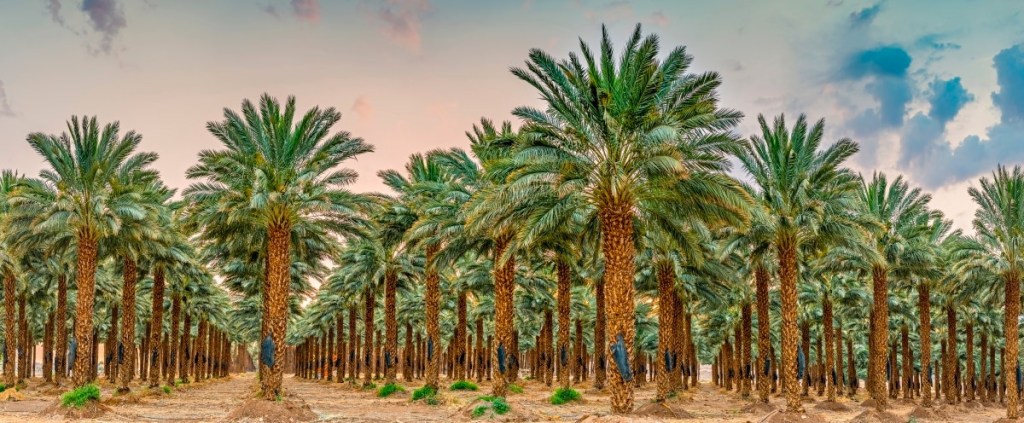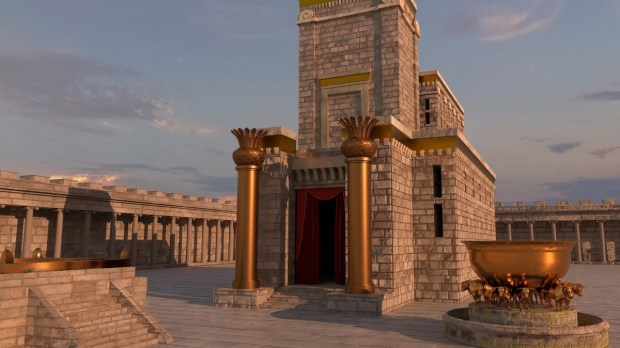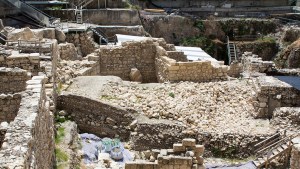When Solomon built a temple for God in Jerusalem, he had stone-carvers cover the walls with a mysterious symbol. “On the walls all around the temple, in both the inner and outer rooms,” say the Scriptures, “he carved cherubim, palm trees and open flowers.” (1 Kings 6:29) The carvings of angels I understand, and of course flowers make for lovely decorations, but I’ve long puzzled over the palm trees.
The detail is clearly important. In Ezekiel’s famous vision of the temple, he notices, “the faces of the projecting walls were decorated with palm trees,” and he also says, “from the floor to the area above the entrance, cherubim and palm trees were carved on the wall of the outer sanctuary.” The temple is a veritable forest of palms.
Our Lord’s final entrance into Jerusalem takes place in the midst of palms as worshipers waved the branches and placed them under his feet. In Heaven, St. John sees the multitude of saints in the throne room of God, praising God and holding palm branches in their hands.
What’s the symbolism of the palm? I believe there are two meanings, one that would have been known to the builders of the temple and one that was a hidden prophecy of Christ.
Symbol of Paradise
To understand the meaning of the palm to the temple builders, we note the importance of the date palm in Israel. There are many species of palm tree, but the date palm was particularly prized because of its fruit.Dates are full of nutritional value, forming a vital part of the diet of people who lived in the semi-arid regions around Israel. In particular, nomads in the desert relied heavily on the date fruit.
Palms can be found all over the Middle East, but they thrive and cluster near springs of water. This means that palm trees mark out garden spots in the desert, the places where water pushes up from the sand to create an oasis. Date palms are signposts of abundance and life, making them a fitting symbol of Paradise. They were even loosely associated with the Tree of Life itself.

The temple in Jerusalem was the home of God on earth, the place where his presence descended in awesome power. Through the sacrifices that occurred there, the sins of the people were forgiven. The temple was the lifeline for the people to renew their broken relationship with God.
The temple was Eden, a Paradise where God walked with his children once again. On their way into the inner courts, the Israelites would have been reminded of this as they passed walls covered with flowers and palm trees. At the center of it all, the altar become a symbol for the tree of life, the place where God saved his people.
Symbol of the Phoenix
There’s a further meaning to the palm trees in the temple. This one prophetically builds on the symbol of the palm as Paradise and reveals an additional level of depth.
The scientific name for the date palm is phoenix dactylifera. The word phoenix is from the Greek language and, when translated, means both palm and sunbird. The Greeks had learned about the sunbird, or the phoenix, from older myths. In particular, they knew about the legendary Egyptian bird that would cast itself into a fire each evening, flaming out in a death of red embers. The phoenix is like the Sun dying in the western sky, only to spread its wings and rise to life again each dawn when the golden Sun re-emerges in the East.
Legend connects the palm to the phoenix, claiming the mythical bird loves to nest in date palm branches because the date palm is notorious for its ability to re-grow after fire damage. The Greeks were fascinated by the phoenix and often planted date palms near their sacred places. For example, there was a famous palm at the altar of the Greek temple of Apollo in Delos. It’s even referred to by Homer in the Odyssey. Apollo was a deity connected to the Sun, so it’s no coincidence that the legend says he was born under that palm.
A connection to Christ
Did the Israelites know about the mythology of the phoenix when they carved palms into the walls of the temple? I’m not really sure, although it stands to reason that they did. Whether they knew or not, it’s hard not to stand in awe as a Catholic looking back from the present-day at the prophetic meaning of the palm and how it connects to Christ.
The palm is a symbol of the Resurrection. Christ is the phoenix who dies and rises again, who spreads his wings like the sun in the east and carries us to the dawn of our second life. He is the light of the world.
Jesus arrived in Jerusalem on Palm Sunday and was acclaimed King and Messiah. The palms waved in his honor show that he is one who will restore Paradise. At the same time, some of the palm leaves were thrown under his feet. They were stepped upon, trodden into the muddy earth. It’s a prophecy.
Our Lord’s victory can only come about through his sacrifice. He must descend into the earth, into death. Only then will the seed, burned by the fires of hell but not defeated, never defeated, only then will it crack open and grow into the great Tree of Life, Christ our Risen Savior.
Christ is the Temple. He is Paradise. He is the way to Heaven and knowing him is Heaven.



